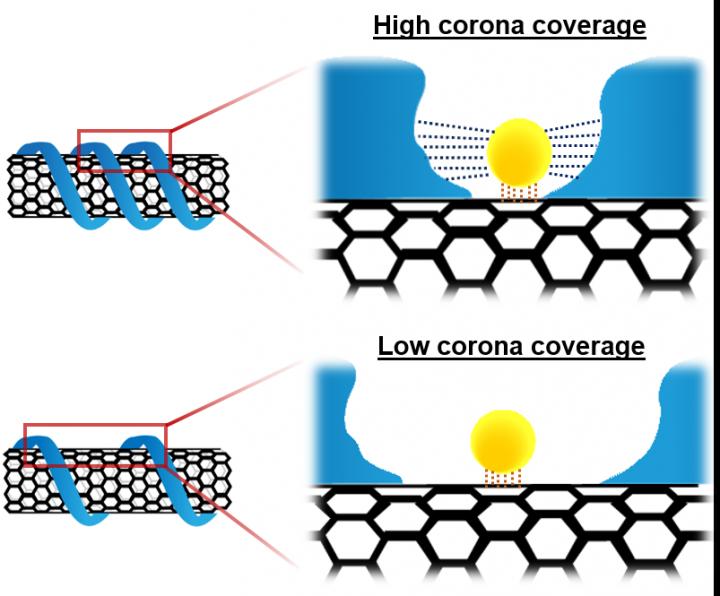
SMART Unveils Faster, Cheaper Method for Nanoparticle Surface Analysis

Schematic illustration of probe adsorption influenced by an attractive interaction within the corona
Credit: SMART
- The Molecular Probe Adsorption (MPA) method is substantially faster and cheaper than existing chemical methods and does not damage the nanoparticle being studied
- It can also be used to 'characterise' nanoparticles with any geometric shape as a universal characterization technique
- The discovery will enable SMART researchers in precision agriculture to develop new plant sensors for hormones and nanoparticle carriers for gene engineering
- MPA will also aid researchers across all sectors to push nanoparticle research boundaries and current limits
Researchers from SMART, MIT's research enterprise in Singapore, have made a groundbreaking discovery that allows scientists to 'look' at the surface density of dispersed nanoparticles. This revolutionary technique enables researchers to 'characterise' or understand the properties of nanoparticles without disturbing the nanoparticle, and also at a far lower cost and far quicker too.
The new process is explained in a paper titled “Measuring the Accessible Surface Area within the Nanoparticle Corona using Molecular Probe Adsorption”, published this month in the prestigious academic journal, Nano Letters. It was led by Michael Strano, co-lead principal investigator of DiSTAP and Carbon P. Dubbs Professor at MIT, and Minkyung Park, Graduate Student at MIT.
DiSTAP, the Disruptive & Sustainable Technologies for Agricultural Precision Interdisciplinary Research Group (IRG) is a part of the Singapore-MIT Alliance for Research and Technology (SMART), MIT's research enterprise in Singapore. DiSTAP IRG develops new technologies to enable Singapore, a city-state which is dependent upon imported food and produce, to improve its agriculture yield to reduce external dependencies.
The MPA method is based on a non-invasive adsorption of fluorescent probe on the surface of colloidal nanoparticles in aqueous phase. Researchers are able to calculate the surface coverage of dispersants on the nanoparticle surface – which are used to make it stable at room temperature – by the physical interaction between the probe and nanoparticle surface.
“We can now characterise the surface of the nanoparticle through its adsorption of the fluorescent probe. This allows us to understand the surface of the nanoparticle without damaging it, which is, unfortunately, the case with chemical processes widely used today,” said Park. “This new method also uses machines that are readily available in labs today, opening up a new easy method for the scientific community to develop nanoparticles that can help revolutionise different sectors and disciplines.”
The MPA method is also able to characterise a nanoparticle within minutes compared to several hours that the best chemical methods require today. Because it uses only fluorescent light, it is also substantially cheaper.
DiSTAP has started to use this method for nanoparticle sensors in plants and nanocarriers for delivery of molecular cargo into plants.
“We are already using the new MPA method within DiSTAP to aid us in creating sensors and nanocarriers for plants,” said Strano. “It has enabled us to discover and optimize more sensitive sensors, and understand the surface chemistry, which in turn allows for greater precision when monitoring plants. With higher quality data and insight into plant biochemistry, we can ultimately provide optimal nutrient levels or beneficial hormones for healthier plants and higher yields.”
###
About SMART Disruptive & Sustainable Technologies for Agricultural Precision (DiSTAP)
DiSTAP is one of the six Interdisciplinary Research Groups (IRGs) of the Singapore-MIT Alliance for Research and Technology (SMART). The DiSTAP programme addresses deep problems in food production in Singapore and the world by developing a suite of impactful and novel analytical, genetic and biosynthetic technologies. The goal is to fundamentally change how plant biosynthetic pathways are discovered, monitored, engineered and ultimately translated to meet the global demand for food and nutrients. Scientists from Massachusetts Institute of Technology (MIT), Temasek Life Sciences Laboratory (TLL), Nanyang Technological University (NTU) and National University of Singapore (NUS) are collaboratively: developing new tools for the continuous measurement of important plant metabolites and hormones for novel discovery, deeper understanding and control of plant biosynthetic pathways in ways not yet possible, especially in the context of green leafy vegetables; leveraging these new techniques to engineer plants with highly desirable properties for global food security, including high yield density production, drought and pathogen resistance and biosynthesis of high-value commercial products; developing tools for producing hydrophobic food components in industry-relevant microbes; developing novel microbial and enzymatic technologies to produce volatile organic compounds that can protect and/or promote growth of leafy vegetables; and applying these technologies to improve urban farming.
For more information, please log on to: http://distap.
About Singapore-MIT Alliance for Research and Technology (SMART)
Singapore-MIT Alliance for Research and Technology (SMART) is MIT's Research Enterprise in Singapore, established by the Massachusetts Institute of Technology (MIT) in partnership with the National Research Foundation of Singapore (NRF) since 2007. SMART is the first entity in the Campus for Research Excellence and Technological Enterprise (CREATE) developed by NRF. SMART serves as an intellectual and innovation hub for research interactions between MIT and Singapore. Cutting-edge research projects in areas of interest to both Singapore and MIT are undertaken at SMART. SMART currently comprises an Innovation Centre and six Interdisciplinary Research Groups (IRGs): Antimicrobial Resistance (AMR), BioSystems and Micromechanics (BioSyM), Critical Analytics for Manufacturing Personalized-Medicine (CAMP), Disruptive & Sustainable Technologies for Agricultural Precision (DiSTAP), Future Urban Mobility (FM) and Low Energy Electronic Systems (LEES). SMART research is funded by the National Research Foundation Singapore under the CREATE programme.
For more information, please visit – http://smart.
For media queries, please contact:
Tazkira Sattar
SMART@bluetotem.co
+65 8280 3055












